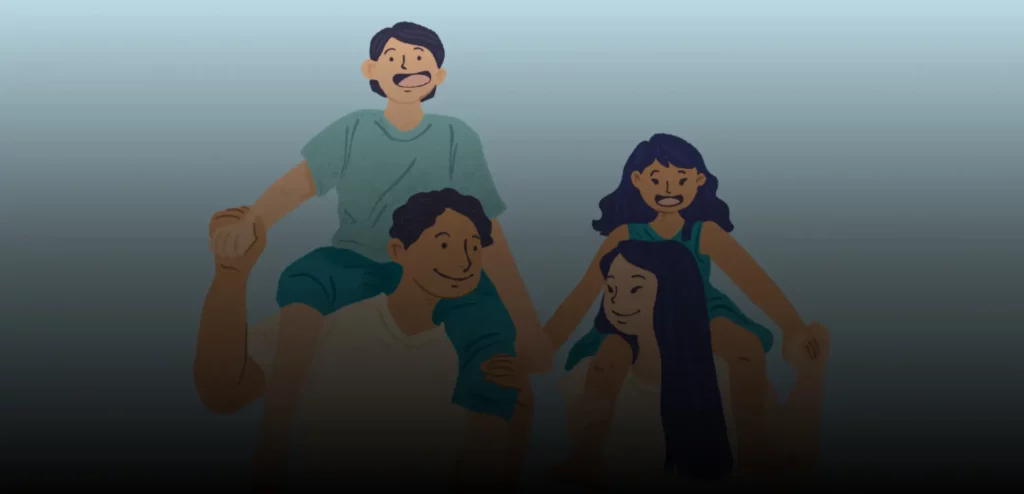Download a PDF of The Oregon Kids’ Credit would be a lifeline for hundreds of thousands of Oregon children
By creating the Oregon Kids’ Credit, the legislature can improve the economic well-being of the children and families struggling the most to get by. Parents across Oregon are struggling with the costs of housing, food, utilities, and other basic needs — a challenge made worse by rapid inflation.[1] The most direct way to address this is to raise the incomes of Oregon families struggling to get by. Creating a refundable state child tax credit – the Oregon Kids’ Credit – would be an effective and efficient way to deliver resources to the families in greatest need.
The Oregon Kids’ Credit is targeted at those who need help most. Estimates show a tax credit of $1,200 per child for Oregon families earning less than $50,000 would lift up more than 200,000 children, and nearly 20,000 would be lifted out of poverty.[2] Moreover, the Oregon Kids’ Credit would disproportionately benefit Black, Indigenous, and Latino children, helping reduce racial and ethnic disparities. It would also disproportionately help children in rural areas, reducing geographic disparities.
The Oregon Kids’ Credit would deliver much needed cash to families
The tax code provides an established and efficient means of delivering cash-like assistance to families struggling to make ends meet. Targeted refundable tax credits in particular can be effective in helping families struggling to pay the bills, as they both lower a family’s tax liability and return any remaining portion of the credit in the form of a tax refund.
The Oregon Kids’ Credit (HB 3235) would establish a refundable Oregon child tax credit of $1,200 per child age 17 and under.[3] Tax filers who file jointly or as head of household would be eligible for the full credit if they earn up to $40,000. Eligibility would gradually phase out by $50,000.[4] Any family who has eligible dependents, meets the income requirements, and files a tax return would be eligible for the Oregon Kids’ Credit.
The Oregon Kids’ Credit would deliver much needed resources to families struggling with the rising costs of raising children. For example, a two-parent household with three children making $20,000 a year would be eligible for a $3,600 tax credit. The Oregon Kids’ Credit would represent an 18 percent increase in that family’s annual income.
The Oregon Kids’ Credit would lift up more than 200,000 Oregon children
The need for the Oregon Kids’ Credit is great. Before the pandemic, more than two in every five Oregon households lacked the resources necessary to make ends meet.[5] Since then, families have faced increased economic uncertainty and rising costs of everyday essentials.
The Oregon Kids’ Credit would lift up more than 200,000 Oregon children.[6] Also, more than 200,000 adults would have additional resources in their household budgets to better afford housing, food, and other necessities.[7] All told, the Oregon Kids’ Credit would improve the economic well-being of more than half a million Oregonians. The credit would lift nearly 20,000 Oregon children out of poverty.[8]
The Oregon Kids’ Credit would also help reduce disparities by race and ethnicity. While children of all races and ethnicities stand to benefit from the Oregon Kids’ Credit, it would disproportionately benefit Black, Indigenous, and Latino children.[9] Oregon’s legacy of exclusionary policies and racist structures means that families of color are more likely to struggle to make ends meet.[10] In part, the Oregon Kids’ Credit would help close that gap.
The Oregon Kids’ Credit would deliver much needed additional resources to parents struggling to get by in every corner of our state. Children in all 36 counties stand to benefit.
The Oregon Kids’ Credit would disproportionately benefit children living in rural Oregon.[11] Oregon children living in rural counties make up about 12 percent of all Oregon children, yet are about 16 percent of all children eligible for the Oregon Kids’ Credit.[12]
Recent experience shows cash works
The benefits of refundable tax credits are well documented. In 2021, Congress temporarily expanded the federal Child Tax Credit as part of the American Rescue Plan. Congress made the credit larger and fully available to the lowest-income families. The result was historic. Thanks in large part to the expanded federal Child Tax Credit, child poverty nationally dropped by nearly half to its lowest rate on record.[13] The gap in poverty experienced by Black, Indigenous, and other children of color and their white peers also narrowed nationwide.[14]
The enhanced Child Tax Credit dollars went to pay for essentials, according to real-time data collected by the Census Bureau in 2021. Among Oregon families earning less than $35,000 per year, 87 percent spent their expanded federal Child Tax Credit on basic needs such as food, clothing, shelter, or utilities.[15]
Besides helping families make ends meet, extra cash has long-term benefits for children. Studies have found that delivering additional money to families with low incomes can have a wide range of positive impacts such as improved health outcomes for children and parents, and increased earnings of child beneficiaries when they reach adulthood.[16] A 2022 National Bureau of Economic Research study estimated that making the expanded federal Child Tax Credit permanent would result in a return on investment of more than ten times.[17]
Unfortunately, the historic expansion of the federal Child Tax Credit expired at the end of 2021. To date, Congress has failed to reinstate and make permanent the enhanced version of the credit. As a result, an estimated 192,000 Oregon children, and millions more nationwide, lost access to the full credit and have likely slipped back into poverty.[18]
Oregon families need the Oregon Kids’ Credit
Oregon families are struggling to get by, and the ability of parents to provide a safe and stable upbringing for their children is only made more difficult by the rising costs of living. Oregon lawmakers have an opportunity this year to lift up more than 200,000 Oregon children by enacting the Oregon Kids’ Credit.
[1] The 12-month percent change for all items in the Consumer Price Index was 6.5 percent in December 2022. Rent increased by 8.3 percent, food by 10.4 percent, and energy by 7.3 percent over the same time period. Consumer Price Index News Release, Bureau of Labor Statistics, January 12, 2023.
[2] OCPP analysis of data provided by the Institute on Taxation and Economic Policy and the Center on Budget and Policy Priorities.
[3] HB 3235, 2023 Regular Session.
[4] Eligibility would be based on Oregon adjusted gross income. Tax filers filing as single would be eligible for the full credit earning up to $20,000 before phasing out by $30,000. Tax filers with dependents and responsible for more than half of a household’s expenses typically file as head of household.
[5] 44 percent of households lived below the ALICE Survivability Threshold in 2018, the most recent year with data. ALICE stands for asset limited, income constrained, employed. The ALICE Survivability Threshold is a measure of the minimum income needed to make ends meet. For more see United for ALICE, ALICE in Oregon: A Financial Hardship Study, United Ways of the Pacific Northwest, 2020.
[6] Estimates provided to OCPP by the Institute on Taxation and Economic Policy.
[7] Ibid.
[8] OCPP analysis of American Community Survey Public Use Microdata Survey (PUMS) data. Modeling of the Oregon Kids’ Credit was provided to OCPP by the Center on Budget and Policy Priorities. The model uses 2017-2019 PUMS data with incomes adjusted for inflation to 2022 and 2022 tax parameters.
[9] OCPP analysis of American Community Survey Public Use Microdata Survey (PUMS) data. Modeling of the Oregon Kids’ Credit was provided to OCPP by the Center on Budget and Policy Priorities. The model uses 2017-2019 PUMS data with incomes adjusted for inflation to 2022 and 2022 tax parameters. Racial and ethnic disaggregation is done using the Oregon Health Authority’s Race, Ethnicity, Language, and Disability (REALD) methodology provided to OCPP by Dr. Marjorie McGee.
[10] For more on Oregon’s racial wealth gap see Addressing the Racial Wealth Gap, Mira Mohsini, Khanya Msibi, and Andres Lopez, Coalition of Communities of Color. For more on how state tax codes can advance racial equity see Advancing Racial Equity With State Tax Policy, Michael Leachman, Michael Mitchell, Nicholas Johnson, and Erica Williams, Center on Budget and Policy Priorities, November 15, 2018.
[11] Ibid.
[12] For the purposes of defining rural counties, we use “Non-urban” counties as defined by Oregon’s minimum wage law. For more see Oregon Minimum Wage, Oregon Bureau of Labor and Industries. OCPP analysis of American Community Survey Public Use Microdata Survey (PUMS) data. Modeling of the Oregon Kids’ Credit was provided to OCPP by the Center on Budget and Policy Priorities. The model uses 2017-2019 PUMS data with incomes adjusted for inflation to 2022 and 2022 tax parameters.
[13] Policymakers Should Expand Child Tax Credit in Year-End Legislation to Fight Poverty, Chuck Marr, Danio Trisi, Arloc Sherman and Kris Cox, Center on Budget and Policy Priorities, October 20, 2022.
[14] Ibid.
[15] Center on Budget and Policy Priorities analysis of U.S. Census Bureau Household Pulse Survey public use files for survey weeks 34-38.
[16] EITC and Child Tax Credit Promote Work, Reduce Poverty, and Support Children’s Development, Research Finds, Chuck Marr, Chye-Ching Huang, Arloc Sherman, and Brandon Debot, Center on Budget and Policy Priorities, October 1, 2015.
[17] The Benefits and Costs of a U.S. Child Allowance; National Bureau of Economic Research Working Paper No. 29854, Irwin Garfinkel et al., March 2022.
[18] Year-End Tax Policy Priority: Expand the Child Tax Credit for the 19 Million Children Who Receive Less Than the Full Credit, Chuck Marr, Kris Cox, Sarah Calame, Stephanie Hingtgen, George Fenton and Arloc Sherman, Center on Budget and Policy Priorities, December 7, 2022.
Posted in Education, Family supports, Poverty & inequality.
More about: child care, child tax credit, healthy kids, tax expenditures






